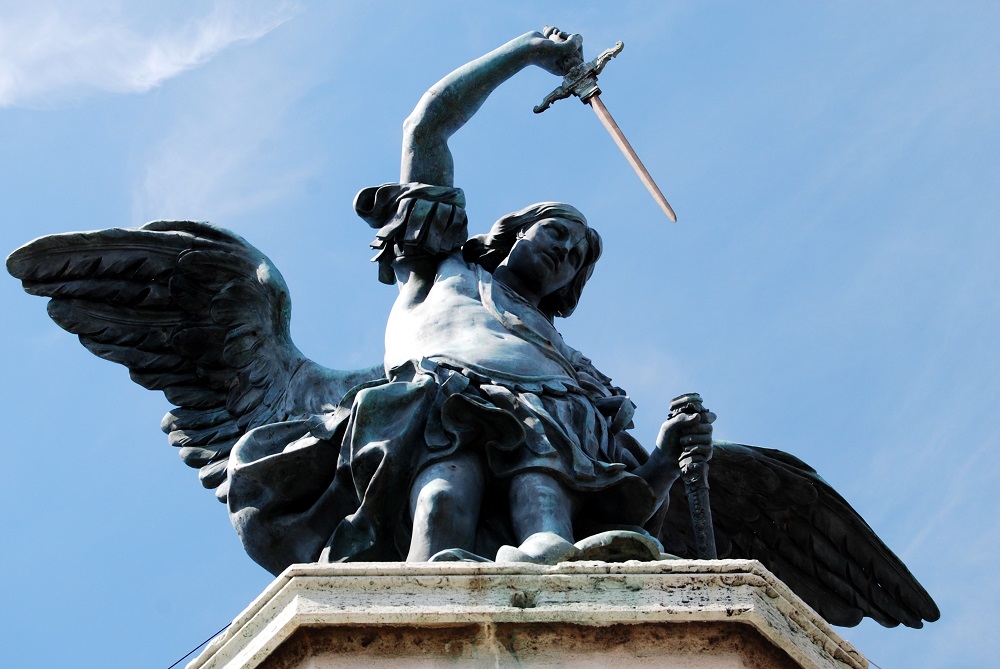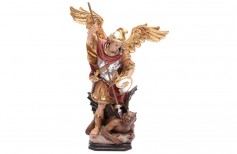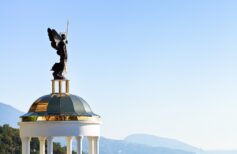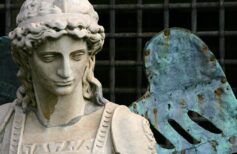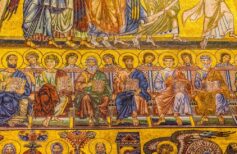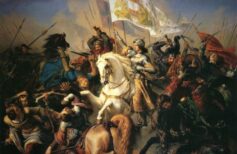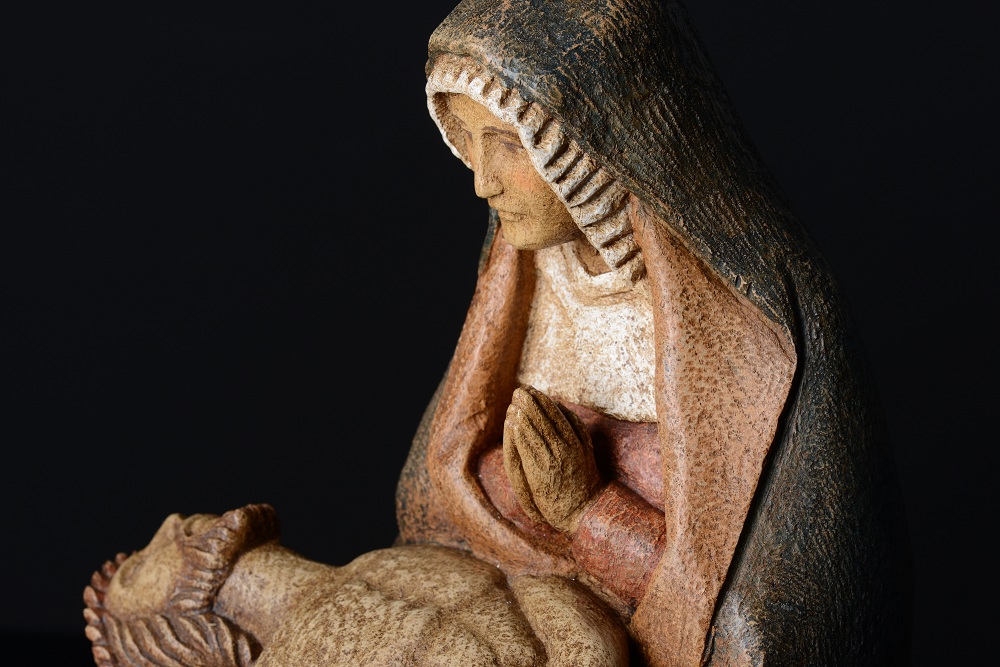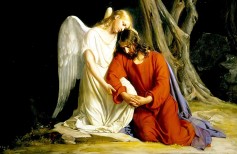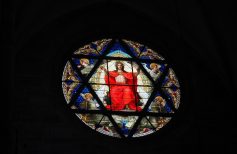St. Michael the Archangel is one of the three archangels recognized by Christianity, and not just that.
Contents
His figure is in fact the object of worship and veneration also by other professions of faith, such as Judaism and Islam. Indeed, he is recognised by all of them as the Archangel par excellence, before this term was used for Gabriel and Raphael. His name means “Who is like God?”, His symbols have always been the sword, or the spear and the armour. Michael is a celestial warrior, indeed, the warrior, commander of the angelic hosts, the one who led the armies of Paradise against Lucifer and his rebels, driving them over the clouds and making them fall to Hell.
For the Muslims, he was the angel who, together with Gabriel, instructed Muhammad with the Koran, an austere and shady angel who never laughed. Some traditions, especially Eastern ones, represent it with a balance in hand, intent on weighing and judging the souls of the dead.
St. Michael the Archangel is an emblematic figure, which crosses the history of Europe, not only the religious, object of veneration by the Byzantines and the Lombards, compared by the latter to the God Odin, which traced the warlike virtues and the war dimension , and elsewhere in Hercules, Mitra, Hermes. His cult has spread to the East and West, leading to the construction of places of veneration placed along a straight line, the so-called Sacred Line, which connects Ireland with Israel, passing through England, France, Italy, Greece.
Patron of many cities and towns, Protector of the Jewish people, Guardian of the Catholic Church, Protector of the Sick and Paramedics; of the Police Forces, from the Police to the Sailors, from the Paratroopers to the Firemen; Radiologists and Grocers and all those who use scales, such as pharmacists, pastry chefs, merchants; of swordsmen, masters of arms; of the gilders; of the manufacturers of tubs,
It is definitely worth knowing it better.
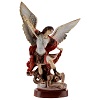
History of Archangel St. Michael
Saint Michael the Archangel in the Bible is mentioned five times, and always as the supreme head of the heavenly army.
Once upon a time he and Lucifer guided the divine militias together, as the most shining among the angels, the strongest, the bravest, the closest to God.
Revelation 12.7-8: 7 Then a war broke out in the sky: Michael and his angels fought against the dragon. The dragon fought together with his angels, 8 but they did not prevail and there was no more room for them in heaven.
After the treason of Lucifer, after his rebellion, the perfection represented by these two angels was broken, and became bitter enemies. Michael made the war against his old brother the reason for his very existence, driving him from heaven, persecuting him through the millennia, defending humanity from its snares and its temptations. Since then the Archangel Michael has become the punisher of all those who rise up against God, the proud, the defenders of the Faith, of Truth, of the Church itself.
As we’ve already written, its name derives from the Hebrew Mi-ka-El which means “who is like God?”
“Archangel” derives from the Greek and is a word composed of àrchein, “comandare” and ànghelos, “messenger”. So the Archangels, and Michael in particular, are those who command the other angels.
Often the cult of St. Michael is intertwined with that of the Virgin Mary. Both fight against the devil, both are represented as they crush it under their feet, in the form of a snake or a dragon. Both, above all, are protectors of humanity, against its flattery, and guardians of God’s flock against Evil. According to an ancient tradition, St. Michael the Archangel will be the one who will play the trumpet of the Judgment announcing the end of the world.
St. Michael the Archangel is celebrated together with the other two Archangels, Gabriele and Raffaele, on 29 September.
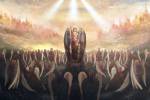
Archangels: who are they and what is their function?
The Catholic Church recognises the existence of only three Archangels, or the three mentioned in the Scriptures: Michael
We have already mentioned how the cult of St. Michael the Archangel spread from East to West, and how its spread in the West was due in large part to the Lombards, who adopted it the sixth century, on the occasion of their travels to Italy, as a great devotion and erected many religious buildings in his name, including the Sanctuary of San Michele Arcangelo on Monte Gargano, in Puglia.
Here, where today stands the village of Monte Sant’Angelo, with its splendid sanctuary dedicated to San Michele, it is said that the Archangel appeared to the young archer Galgano, while he was chasing a marvellous white bull. Through the intercession of the Archangel the arrows thrown against the bull came back and struck his hunter, who converted to Christianity.
It was Pope Gregory the Great who brought the Lombards to conversion, above all thanks to Queen Teodolinda. Saint Michael immediately liked these ferocious warriors from the north, because he embodied Odin’s talents, and chose him as protector. Thanks to the Lombards the cult of San Michele spread throughout northern Italy.
Even today there are testimonies of this diffusion in Pavia, former capital of the Lombard kingdom, and in the Val di Susa, in Piedmont, where the Sacra di San Michele still stands, a monastery perched on the peak of Mount Pirchiriano, which was for centuries used by pilgrims between Italy and France. This superb architectural complex was inspired by Umberto Eco for his novel ‘Il Nome della Rosa’.
The sacred lay line of Archangel St. Michael
We have also spoken about the sacred line that connects all the most important places of worship dedicated to St. Michael the Archangel, otherwise known as the Ley Line of St. Michael:
- Skellig Michael in Ireland
- St Michael’s Mount in Cornwall, England
- Mont Saint Michel in Normandy, France
- the Sacra di San Michele in Val di Susa,
- San Michele, Monte Sant’Angelo, Puglia
- San Michele Monastery on the Island of Simi, Greece
- Monastery of Monte Carmelo in Israel.
Besides being along the same, imaginary straight line, three of these important places are also equidistant from each other: these are Mont Saint Michel in France, the Sacra di San Michele in Val di Susa and the sanctuary of Monte Sant Angelo on the Gargano.
“Ley Lines” are straight lines that join places on the Earth that have always been considered special, perhaps energy nodes of the planet, whose meaning is impossible to trace. The Ley Line of St. Michael, or Ley Line of the Dragon, is, among other things, perfectly aligned with the setting of the Sun on the day of the Summer Solstice. It is therefore no secret that, since ancient times, the cult of Archangel St. Michael has been studied from many perspectives, following suggestions that often transcend religion and the spiritual value of places of devotion.

Prayers to the Archangel St. Michael
We have already mentioned that sometimes the cult of St. Michael the Archangel is associated with that of the Virgin Mary. Both are emblems of the fight against evil, both are guardians and protectors of humanity, both fight the Devil, crushing him under their feet, driving him to hell.
Prayers which are addressed to St. Michael the Archangel are above all requests for help, protection.
The Prince of the Celestial Militia relies on it in the everyday troubles, but also in view of the Last Judgment. It is invoked as a guide, as a protector, as a shield against evil and support. Never as in the prayers addressed to other Saints it is clear that the invocations to St. Michael the Archangel are real weapons of faith, to be challenged in daily battles. And how could it be otherwise, given the iconography that characterizes this beautiful and implacable Archangel? Since the origins of his cult, therefore, invocations, consecration, angelic crowns were dedicated to St. Michael the Archangel.
One prayer in particular deserves further study. It was written in October 1884 by Pope Leo XIII, following a frightful vision in which the Devil threatened to destroy the Church and Saint Michael stood in his defence. Leo XIII made it law that this prayer be recited at the end of each mass, and inserted it among the most powerful exorcisms, in Exorcismus in Satanam et Angelos Apostaticos. This exorcism hides a prophecy that touches us closely, given that the exorcism dates back to the nineteenth century, and speaks of events that would take place in the immediate future.
According to the prophecy, Lucifer and his allies will take control of the Papacy, but nevertheless they will not succeed in destroying the Church. Exorcism can only be recited by an authorized priest, but the prayer written by Leo XIII can be recited by the faithful, and although it is not as efficacious as exorcism in the case of overt possession, it can prevent possession from taking place, protecting those who have been targeted by the evil one.
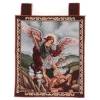
We report only the abbreviated version reported by the Roman Ritual and published in 1902:
Glorious Prince of the Celestial Militia, Archangel Saint Michael,
Defend us in this ardent battle against all the powers of darkness and their spiritual malice.
Come to the aid of men, whom God created immortal, made in his own image and likeness, and redeemed at a great price from the tyranny of the devil.
You are revered by the Holy Church as her guardian and patron, and to you, the Lord has entrusted the souls who will one day occupy the heavenly seats. “Oh, pray to the God of peace, that He may put Satan under our feet, conquered so resoundingly that he will no longer be able to hold men in captivity and harm the Church.
Present our prayers to the Most High, with your own, so that His Divine Mercies will descend upon us soon, and you can chain the dragon, the ancient serpent Satan, and throw him into the abyss. Only in this way will he seduce souls no longer.
Since the prophecy and exorcism of Leo XIII, it is clear that now, more than ever, the gravity of what is happening around us, the succession of wars, suffering, prevarication, which are now so frequent and constant they have been normalised, and are taken for granted, requires the intervention of a benign force, equipped with the appropriate weapons to defeat evil. The Archangel St. Michael is a symbol of inexhaustible spiritual strength, courage, loyalty, purity still capable of guiding and saving souls who wish to follow the right path.
Another prayer dedicated to St. Michael the Archangel worth mentioning is the angelic Crown, composed by Antonia de Astonac, a Portuguese Carmelite, in 1751. Recognised by Pope Pius IX, it is a sort of Rosary which is addressed above all to the Archangels and the angelic choirs. It is in fact made up of an invocation to God (Gloria), an invocation (composed of one Our Father and three Hail Marys) for each of the nine angelic choirs, and four Our Fathers, three for each of the Archangels and one for the Guardian angel.
Representations of St. Michael the Archangel in art and the collective imagination
In general, the salient features with which Saint Michael Archangel is depicted are armour, a sword, or a spear, with a warlike posture. Since the cult of St. Michael the Archangel was founded in the East, or in any case in the Byzantine area, he is very often depicted with elegant robes, like a Byzantine dignitary, as can be seen in many of the icons of St. Michael the Archangel, as well as in the works of Simone Martini, for example.
In this context, the Saint is usually dressed by a purple cloak or the imperial loros; in his hand he carries the Labar, a banner bearing the trisághion, an ancient anthem, bearing the text: “Holy God, Holy Strength, Holy Immortal, have mercy on us.” As regards the Byzantine’s devotion to St. Michael,, it is worth remembering that Emperor Constantine I had the Michaelion built in his name in Constantinople, a huge sanctuary, while in the West the first basilica dedicated to St. Michael probably dates back to the fifth century.
As regards Byzantine iconography, the western tradition prefers Saint Michael presented at the Apocalypse, a as celestial warrior, a prince in armour with his wings spread, who guides the divine armies against the Evil One. The Archangel Michael is generally depicted on foot, in the form of a young beardless, hieratic man, with his wings spread, a spear or a sword in his hand, and a crossed globe in the other. He wears a flowing tunic, sometimes a cloak, but is always the armour.
On the contrary, we owe the Islamic tradition the occurrences, in some representations of him, to a scale, that the Archangel uses to weighs souls, with a view to their Judgement. This is a tradition that has its origins in paganism, in particular in the Egyptian myth of Osiris, and in Persian mythology, but has been portrayed by many artists. It spread, particularly in the Romanesque-Gothic context, to both the East and West. In this interpretation, St. Michael the Archangel appears as protector of the dead, their psychopomp or guide, as was Hermes or Charon in the Greek tradition, and as a weigher of souls.
Moreover, the iconography of Saint Michael, as he appears in the icons, paintings and statues that depict him, owes much to that of gods and heroes of pagan mythology, in which a heroic figure appears at the end of time, and defeats Evil, which is often represented by a monster. Think of the Babylonian god Marduk, of Mithras, or Hermes, all of them are connected by the characteristic of being a mediator between the heavenly powers and man, the bearers of light and salvation, which we also find associated with St. Michael.
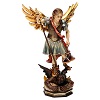
As regards the statues dedicated to Archangel Michael, they are innumerable, and again take on the pictorial iconography of the warrior armed with a sword that defeats the Devil, or a Dragon, as well as the more oriental interpretation of a St. Michael who judges the souls of men.
In addition to the Byzantine and Romanesque bas-reliefs, of which there are many examples all over the world, we can consider in particular the Statue of the Archangel Michael in the Basilica at Monte Sant’Angelo, or the numerous statues of San Michele that succeeded on the top of Castel Sant ‘Angelo in Rome, the first, in wood, since the eleventh century, and finally, the San Michele di Raffaello by Montelupo, made from marble and metal, with magnificent painted wings, which unfortunately have been lost, and the bronze statue by Peter Anton van Verschaffelt, which was erected in 1752, and even today, watches over the Eternal City.

